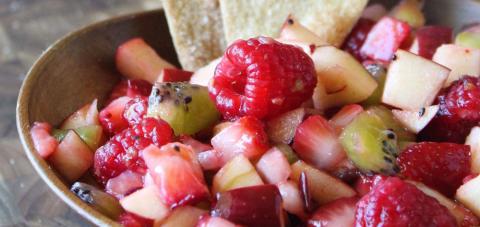
If you are looking to make changes to your family’s eating and physical activity habits, remember that small changes can have a huge impact on health over time. Consider starting with one or more of these recommendations adapted from the Academy of Nutrition & Dietetics:
- Shop smart. To encourage a healthy lifestyle, get your children involved in selecting the food that will appear at breakfast, lunch, and dinner. While gathering grocery shopping ideas works well with older children, consider adapting this recommendation for younger children. You choose which food group you want your preschool-age child to eat. Then, give them a choice between two options within that food group. For example, you could say, “Would you like yogurt or string cheese for your snack?” This encourages a balanced eating pattern while giving your young child a sense of control over their own food choices.
- Cook and eat together. Involve your children in preparing meals. Just be sure to choose age-appropriate tasks to set everyone up for success. For a preschool-age child, this might look like washing grapes, spreading peanut butter on bread, stirring ingredients, or pushing buttons on the microwave. Sit down as a family whenever possible to enjoy a meal together. Family meals encourage bonding and good eating habits, even if it’s only a couple times a week.
- Healthy habits. As the role model of your household, one of the best things you can do to help your children form healthy habits is set a good example. Fill half your plate with fruits and vegetables, choose lower-sodium options, and make at least half the grains your family eats whole grains. For beverages, choose water over drinks with added sugars most often.
- Get moving. Aside from being a great way to spend time together, regular physical activity strengthens muscle and bones, promotes a healthy body weight, supports learning, develops social skills, and builds self-esteem. Preschool-age children are encouraged to be active throughout the day, while older children and adolescents need at least 60 minutes of moderate to vigorous activity daily. This doesn’t need to be accomplished in one shot, so encourage mini activity breaks to get that blood pumping throughout the day.
Have fun, eat well, and be active together—you won’t regret it.
Ideas for age-appropriate cooking activities you could try today! (*All tasks should be done with the guidance and supervision of a caring adult.)
3-5 Year Olds:
- Rinse fruits and vegetables with cool tap water.
- Mix dry ingredients in a large bowl to prevent spills.
- Brush cooking oil on foods.
6-7 Year Olds:
- Use a peeler to peel washed fruits and vegetables.
- Deseed tomatoes and sweet peppers with a spoon.
- Snap fresh green beans and peas.
8-9 Year Olds:
- Open cans with a can opener.
- Crack and beat eggs.
- Juice a lemon or orange.
10-12 Year Olds:
- Microwave foods.
- Follow a recipe and measure ingredients.
- Slice or chop vegetables.
Sources:
Helping Kids Maintain a Healthy Body Weight: A Cheat Sheet for Success, Academy of Nutrition and Dietetics
Klemm, Sarah. Teaching Kids to Cook, Academy of Nutrition and Dietetics
What is MyPlate?, United States Department of Agriculture
This newsletter has been peer reviewed and written in 2021.
Feedback Form
Feedback Form
If you do not see the article, please scroll up the page.








